11202 A GILDED GROUND FAUX ENGRAVING ON GLASS OF A BALLOON FLIGHT BY MONSIEUR BLANCHARD AT THE CORONATION FEAST OF THEIR IMPERIAL MAJESTIES IN 1804 French. Circa 1804. Measurements: Height: 16 1/2″ (42 cm) Width: 12″ (30.5 cm).

Research
Etched gold leaf on glass.
Marks:
Signed lower left:
Lefêbre, sc
Inscribed at bottom in French:
Mr. Blanchard, Pensionaire de S M. Très-Chrétienne, et Correspondant des plusieurs Academies
and:
Montage du Ballon de Mr. Blanchard au fête du Couronnement de leurs Majestés Impériales les jours Decembre 1804
Provenance:
William A.M. Burden Estate
This very unusual gold-leaf engraving on glass depicts a balloon voyage made at the Place de la Concorde, Paris, on the occasion of the coronation celebration of Napoleon I in December of 1804. Interestingly, the best known and documented aerial display performed there for the event was conducted by the balloonist Jacques Garnerin, however, the inscription of the present picture bestows the honor on another famous French aeronaut, Jean-Pierre Blanchard (1753-1809). It reads:
Montage du Ballon de Mr. Blanchard au fête du Couronnement de leurs Majestés Impériales […] Décembre 1804
It is possible that the present commemorative engraving was produced in advance of the coronation, and arrangements were changed for the actual event.
Blanchard (1753-1809) was a French inventor and pioneer of Balloon flight. He made his first successful flight in Paris in 1784, and soon began different experimentations, including a notable contribution to the development of the parachute. He also invented oars or wings with which to propel the balloon in a desired direction, but this proved unsuccessful. Blanchard’s failure was redeemed, however, in January of 1785 when he made the first successful flight across the English Channel. Upon this triumphant crossing of the straits from Dover from England to the town of Calais in France, a monument was erected on the site of his landing and King Louis XVI granted him a pension of 1,200 livres for life.
He was also an important figure in the history of aeronautics overseas. American statesman Benjamin Franklin, together with John Adams and John Jay had been in Paris in the early 1780s and bore witness to the early ballooning demonstrations. As the leading European balloonist of the time, Blanchard was invited make the first flight in the United States in the presence of President George Washington at the nation’s capital, Philadelphia, on January 19, 1793.
In 1804, Blanchard married Marie Madeline-Sophie Armant, herself an accomplished balloonist. They made a number of ascents together but, as Blanchard’s health and success began to decline, Sophie’s fame as a solo balloonist was on the rise. Jean-Pierre met his fateful end in 1808 after he had a heart attack while in his balloon at the Hague, causing him to fall out of it. He died roughly a year later from the severe injuries he sustained.
Sophie, meanwhile, was highly favored by Napoleon and was named official balloonist of France. She was asked to perform demonstrations for state and personal celebrations such as the marriage of Napoleon to his second wife, Marie Louise of Austria, and the birth of his son in 1811. Unfortunately, she too met a similar fate and fell to her death from a balloon in 1819.
Certain details in the present engraving are closely related to an engraving of Garnerin’s demonstration after a drawing by Louis Le Coeur, entitled “Fete du sacre et couronnement de leurs Majestes Imperiales” (figure 1), namely the neoclassical buildings and particular members of the crowd such as a couple running toward the spectacle and a trumpeter on horseback.
There exists in the Smithsonian National Air and Space Museum another glass and gold-leaf engraving commemorating Monsieur Blanchard’s first flight across the English Channel in 1785 (figure 2). It bears an identical profile medallion of Blanchard surrounded by the same inscription: Mr. Blanchard, Pensionaire de S M. Très-Chrétienne, et Correspondant des plusieurs Academies. It also includes an illustration of his ballon and brief description in German of the flight. The same medallion in reverse has been found on other images of Blanchard as well, for example an engraving commemorating an ascension made by Blanchard in Nuremburg in 1785 (figure 3).
This picture, along with four others forming a group, represents a period in the late eighteenth and early nineteenth century when all of Europe, and France in particular, became preoccupied with the hot air balloon experiments made by inventors and early aeronauts, and it formerly belonged to the William A.M. Burden collection (as described in Carlton Hobbs Inventory No. 11201).
(Complete group of ballooning images comprises Carlton Hobbs Inventory Nos. 11201, 11202, 11203, 11204 and 11205.)

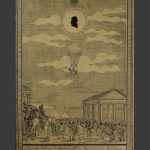
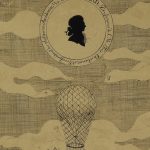
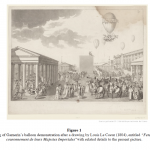

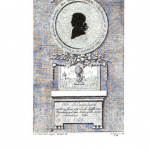
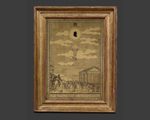
Comments are closed.